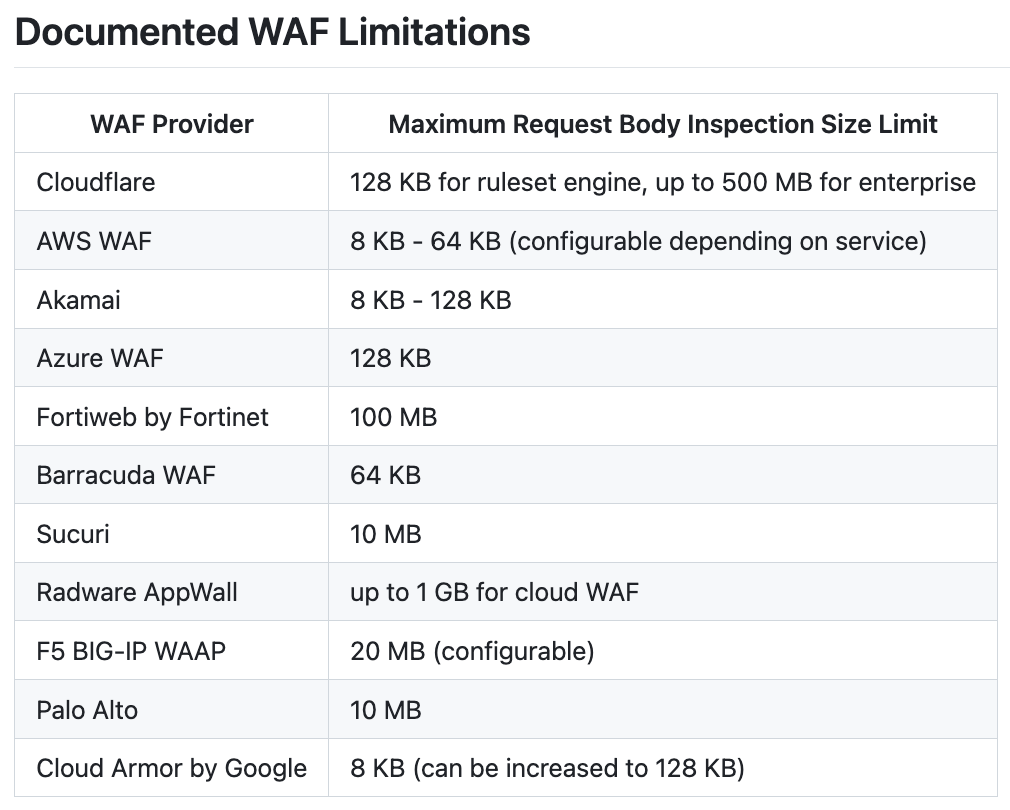WAF as a weapon and DOS as a bullet
Published in zhero_web_security, 2024

After listening to the excellent talk by Shubs on WAF bypass techniques at NahamCon 2024 [1], I had a small idea.
Request size limits bypass
One of the techniques mentioned during the talk was about the “request size limits”, to put it simply:
The default configuration of WAFs does not allow for the analysis of the entire request for obvious performance reasons. The WAF, being situated somewhere between the client and the server, must be able to forward the request quickly to avoid negatively impacting the user experience. Site/platform owners are looking for this balance between UX and security.
The technique - applicable to requests containing a body - simply involves adding a parameter with a value that must be greater than or equal to the size limit set by default by the WAF in question (the limits can differ from one WAF to another) and then adding our parameter containing our payload. The WAF will thus skip its analysis and allow the bypass.
 Source: https://github.com/assetnote/nowafpls
Source: https://github.com/assetnote/nowafpls
Parameter value reflected in cookies
During my research, I often come across parameters whose values are reflected in cookies. Their function is often “marketing” or used to track the user’s journey on the target platform for A/B testing or other similar purposes. I was trying out some techniques to see if anything interesting could be derived from them, but very often there isn’t much to gain.
Using the bypass mentioned above, it is possible to “DOS” a user and make a site inaccessible to the target for a duration depending on the lifespan of the cookie.
How?
There are three prerequisites:
- The parameter reflected in the cookies must be transmitted via a request containing a body (such as
POST). As explained earlier, the request size limit bypass does not work via aGETrequest. If the parameter is transmitted via aGETrequest “by default”, try passing it in aPOSTrequest and check that the cookie is still set, this will indicate that the parameter in question is also processed independently of the HTTP verb used (for these two at least), this is obviously not always the case but it happens - The request should not contain CSRF protection, which is quite often the case for unauthenticated requests or those not transmitting sensitive information
- And of course, the target must be protected by a WAF, where the configuration concerning the maximum inspection size of the content body has not been changed (or is “capped”)
You then need to create a basic HTML page - similar to a CSRF PoC - to send the crafted POST request, placing a payload that would typically be blocked by the WAF such as:
' OR SLEEP(10);--
as the value of the parameter reflected in the cookies. This should be preceded by a parameter designed to “tank” the WAF with a value equal to or exceeding the WAF’s maximum inspection size limit, allowing the bypass.

Since response inspection is not enabled by default on (or most) WAFs, the malicious value can make the round trip without issues: Server –> Client.
Example with AWS WAF:
If you don’t configure any of the response inspection options, response inspection is disabled. [https://docs.aws.amazon.com/waf/latest/APIReference/API_ResponseInspection.html]
The request is therefore sent to the server, which will return the value and assign it as a cookie.
From this point on, -cookies from the request being inspected- each time the victim client attempts to navigate the site, the WAF will block his requests, resulting in a 403 error for the duration of the cookie’s lifespan (1 month in my case, arm yourself with patience).
So:
- during the initial request containing the malicious payload, the bypass request size limits was used
- on return, the WAF does not inspect the response containing the malicious payload - in the
set-cookieresponse header - coming from the server - all subsequent requests from the victim will include the malicious payload in his cookies -without bypass this time-, and therefore will be systematically blocked by the WAF

The informed user can of course get rid of the curse by deleting cookies from his browser. In terms of pure impact for this specific case, it’s not exceptional, it’s a kind of targeted DOS requiring user interaction. The victim must go to the attacker’s site from where the request will be automatically sent and the cookie set.
You would have understood, it can be used in different ways even via XSS. Always useful when you need to demonstrate an impact and you have nothing on hand after going around.
The extremely high frequency of WAFs being bypassable through this technique makes the presence of this vulnerability quite common. This, because the two other constraints mentioned above are not particularly rare.
Published in June 2024.
[1] #NahamCon2024: Modern WAF Bypass Techniques on Large Attack Surfaces
